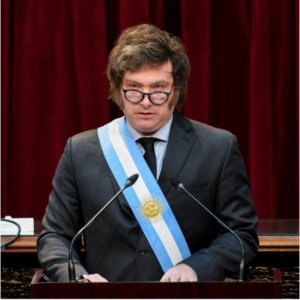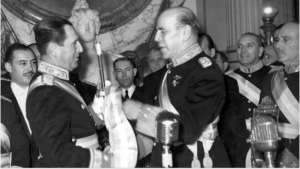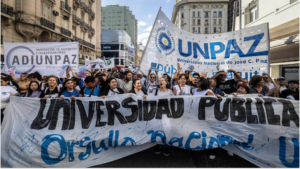17-year-old Camilla Savelieva explains Argentina’s economic woes from the 20th century to now

Argentina’s president Javier Milei, March 2024.
Picture by: Cámara de Diputados de la Nación
Article link copied.
February 21, 2025
How Argentina went from ‘almost an aristocracy’ to being crippled by poverty, debt and inflation
In the early 20th century, Argentina was seen as one of the richest countries in the world – if someone was wealthy, they were said to be “as rich as an Argentine”.
Landowners “almost became aristocracy” by taking land from indigenous people and using it for agriculture, Dr William Michael Schmidli, a historian in US foreign relations at Leiden University, told Harbingers’. They were, he said, obsessed with France as a symbol of “grandeur” and “modernity”.
Yet, in the later decades of the century, the collapsing mansions in Buenos Aires, once “the symbols of the great wealth of Argentina”, became the “the symbols of the great promise Argentina was never able to realise”.
How did a nation with the potential to become, in Schmidli’s words, a “massive industrialised power” similar to the US, become crippled by triple-digit inflation, fiscal deficits and soaring external debt?
Harbingers’ spoke to some experts on the region and its history to analyse the question and find some answers.
Harbingers’ Weekly Brief
The rise of Juan Perón and Peronism
Argentina’s economic growth began to decline significantly in 2000. American investigative journalist John Dinges – who has spent decades reporting on Latin America and especially Chile – told Harbingers’ that the origins of this economic decline can be traced back to “rapid inflation and overspending by the government”.
He continued: “This goes back to the ‘Peronist’ welfare state, which has never been fully funded by the capitalist sector; overtaxation has always been insufficient to cover the costs of social welfare programs. Yet subsequent governments have continued to subsidise social goods like transportation, telecommunications, hence running at a deficit.”
The complex, polarising and hugely consequential ideology of Peronism is a key part of the answer to the Argentinian economic question. Peronism had its beginnings in 1943, when the government was overthrown by a military coup by the United Officers Group, which included army colonel Juan Perón. As minister of labour, Perón introduced policies to help urban industrial workers, gaining massive popularity and eventually becoming president in 1946.

Argentine president Juan Perón (left) and his predecessor, Edelmiro Farrel, June 1946.
Picture by: Archivo General de la Nación Argentina
According to Schmidli, although Peron didn’t “fit the mould of a fascist exactly”, he had tendencies toward that kind of authoritarianism and certainly an “appeal to ordinary people” in the same way that Mussolini had crowds chanting his name.
Schmidli added that Peron “vilified the landowning elites” from the beginning, characterising them as “impeding progress” and “preventing ordinary Argentines from achieving their full potential”.
For Dr Arne Kislenko, who teaches history at Toronto Metropolitan University, Peronism offered a “third way” in that the movement was firmly opposed to both communism and American-dominated democracy/capitalism.
Due to the populist nature of Peron’s government – containing elements of authoritarian, right-wing nationalism such as political oppression and censorship of the press, as well as left-wing economic measures that gained the support of Argentina’s lower-middle class and labour unions – Peronism was established as a system of corporatism in which large interest groups negotiated among themselves, and with the state, for resources.
In the short term, Perón presided over a seemingly flourishing economy. He paid off Argentina’s foreign debt, allowed the country to launch its own iron and steel industry in 1947, manufacturing farm machinery, planes and cars, with shipbuilding expanding 500% under his regime.
But in the long term, his reforms were simply not radical enough to underpin lasting progress – neither capitalism nor socialism, but somewhere in between, with many of the improvements for workers disintegrating along with the economy, into which he had embedded inflation.
Perón’s government collapsed and he fled to Paraguay in 1955 in the midst of his ideological conflict with the Catholic Church, a faltering economy and after the death of his wife, Eva Perón, known as Evita, a charismatic actress adored by the public.
Factional conflicts in the aftermath of Perón’s exile weakened the movement, but Peronism remains a powerful force within Argentine politics to this day.
Military dictatorship, the ‘Dirty War’ and foreign intervention
After a period in exile, Perón returned to Argentina in 1973 and again became president, but his sudden death the following year plunged the country into chaos and extreme economic hardship. His third wife, Isabel, was politically inexperienced and ousted from government in 1976 by a military junta that had become confident in its aspirations to “transform the fabric of Argentine society”.
According to Schmidli, the military regime aimed to do this by “violently quashing” leftist and liberal groups, plunging the country into a period of state terrorism. “When they uncovered the secret prisons in Argentina they found a book on the dietary needs of sharks,” said Schmidli.
Schmidli said there was a “fundamental problem” within the fabric of Argentine politics: the military was becoming “increasingly politicised”, seeing its role as more than just national defence. Part of this increasing involvement in politics was down to the economic and political unrest plaguing the country, but also to training at US facilities that taught free-market economics, in order to “expand” the role of the military to areas usually reserved for civil society, such as economics and the basics of government.
The history of foreign intervention in Argentina is a long and complex one, especially due to the ideological divide and increasing militancy during the Cold War. Kislenko told Harbingers’ that the rise of global tensions between the United States and the Soviet Union heightened domestic political friction within Argentina.
Moreover, according to Dinges, international intervention in internal Argentine politics by foreign governments – the US in particular, which saw Argentina as its “exclusive sphere of influence” – was a force in preventing “alternate models to Western capitalism” being created in Latin America.
For Dr Francesca Lessa, associate professor of international relations of the Americas at University College London, the fascist military coup of 24 March 1976, was a “missing piece” that enabled the region’s military regimes to fully cooperate to “silence dissidents” beyond borders – the infamous network known as “Operation Condor”.
Argentina, by the mid-1970s the last remaining democracy in South America, was the place where thousands of exiles and dissidents had sought refuge. With the 1976 coup, Argentina was described by Lessa as going from a “safe haven” to a “death trap” for numerous exiled dissidents.
Kislenko explained that the “Dirty War” – the politicide and mass torture of the left conducted by Argentina’s fascist military junta led by Jorge Rafael Videla – is the best example of US influence in Argentina.
“Well aware” of the persecution, and indeed supportive of the Argentinian military in its anti-communist suppression, governments in Washington played a “major role” in the brutal “Process of National Reorganisation”, said Kislenko.
It is estimated that up to 30,000 people died or were ‘disappeared’ during the junta’s regime, which lasted until 1983. With the Americans as “principal financiers” and “organisers” of Operation Condor and the Dirty War, human rights and political engagement in Argentina suffered, particularly on the left.
The military dictatorship came to an end in 1983 with the return of what Kislenko calls “more democratic governance” and “dramatic changes in the political landscape”. However, the effect of Cold War divisions, particularly during the Dirty War, remains a “deep scar on Argentinian society”. Indeed, some consider the Dirty War “tantamount to a genocide” and it is still a “major part of the collective consciousness of the country and its people”, explained Kislenko.
Dinges described the dictatorship as responsible for birthing “revanchism” (a desire to retaliate politically, often violently) in Argentina and across Latin America, as well as crumbling political participation due to a complete “loss of political confidence” of Argentine citizens after the politicide.
“If you look at political participation rates now, they’re a fraction of what they were in the 1970s. So many feel they gave their all to create a new society and it was completely obliterated. The cultural effect of the mass repression could go on forever. It’s just enormous – and it’s negative,” Dinges said.
Aside from the deep political scars left by the dictatorship, the military junta was also largely responsible for Argentina’s irresponsible policy of “massive borrowing”, which paved the way for the hyperinflation that to this day cripples the country’s economy.
With the current president, the radical ‘outsider’ Javier Milei, hailing from the extreme economic right, experts like Dinges say we mustn’t downplay the role of a fascist government in bringing about many of Argentina’s economic problems.
Neoliberalism strikes again
The military junta had three main goals – to eliminate any threat to its rule, hold down wages and encourage foreign investment, and steer the economy towards a more neoliberal model, a free market-oriented system that seeks to reduce state influence on the economy through laissez-faire economics.
However, Argentina’s “protracted economic crisis” worsened in the late 1970s, in effect contributing to “growing disenchantment with the military government and its cosy relationship with Washington,” explained Kislenko. By the early 1980s, partially due to the military’s handling of the nation’s economy, there was “rampant inflation”, a soaring international debt, and many businesses and industries in the country collapsed.
According to Dinges, the adoption of neoliberalism heralded the “beginning of the internationalisation” of Argentina economically, politically and, to a certain extent, socially and culturally.
Dinges explained there was no way to easily impose that kind of economic programme, which “displaces millions of workers” from very good, unionised jobs that could have “brought them into the middle class”, without silencing dissenters through violence. In a gigantic giveaway, state-owned assets were “turned over to the private sector” in a “recapitalisation of the economy”, creating a long-lasting foundation of inequality.
Carlos Menem, Argentina’s president from 1989 to 1999, greatly exacerbated many of the problems of neoliberalism through a process of manic privatisation that caused profits to leak out of the country. Hyperinflation was replaced by pegging the peso to the dollar, which inevitably led to an overvaluation of the currency, all while state expenditure rose 50% and Argentina’s debt ballooned.

Protesters march against cuts to Argentina’s universities, Buenos Aires, April 2024.
Picture by: Rosana Alvarez Mullner | Alamy
Argentina today
The country’s failed economy is partly what fuelled the rise of self-declared “anarcho-capitalist” and right-wing libertarian Javier Milei, Argentina’s current president, who was the shock winner of the 2023 election.
Government spokesperson Manuel Adorni blamed the previous left-leaning Peronist government for the country’s economic woes. “The government inherited a disastrous situation, the worst inheritance that a government has received in a democracy, perhaps one of the worst that a government has received in history,” he told a press conference in September 2024.
Congress has passed extensive reforms that deal primarily with taxes, foreign investment and privatisation of previously state-owned entities but will touch every sector of the economy.
Though a significantly modified version of President Milei’s original proposals, cut down from 600 articles to just 238 to win allies in a Congress where Milei’s La Libertad Avanza coalition does not hold a majority, the reforms herald further austerity for Argentina.
Milei’s determined drive towards a fiscal surplus (where government tax revenues exceed spending) has resulted in the halting of state infrastructure projects, with tens of thousands of construction workers being laid off.
In April 2024, tens of thousands of students and university professionals took to the streets to protest against spending cuts to state-run universities. Protests erupted again in June against the administration’s austerity measures, with Argentines from every walk of life chanting “Our country is not for sale!” as police retaliated with water cannons and teargas.
The country has seen triple-digit inflation, massive job losses and rising homelessness. As of October 2024, half of Argentina’s population of 46 million were living in poverty, with figures for the first half of 2024 up more than 11% compared to the second half of 2023.
But at the end of 2024, a year after Milei took power, things seemed to be moving in the right direction. Monthly inflation has plummeted, the peso is stronger and foreign investors are more confident – though many Argentines are still feeling the pain of the brutal austerity policies. Argentines wait, with bated breath, to see what the future holds.
Written by:

Economics Section Editor 2024
United Kingdom
Camilla was born in 2007 in London. She joined Harbingers’ Magazine in 2023 as one of the winners of the first edition of the Harbinger Prize. In 2024, she became the Economics editor for the magazine.
She is interested in politics, history, and economics and enjoys writing about these subjects. Camilla speaks English, Russian, French, and Spanish. In her free time, she enjoys debating, reading and singing.
🌍 Join the World's Youngest Newsroom—Create a Free Account
Sign up to save your favourite articles, get personalised recommendations, and stay informed about stories that Gen Z worldwide actually care about. Plus, subscribe to our newsletter for the latest stories delivered straight to your inbox. 📲
© 2025 The Oxford School for the Future of Journalism


